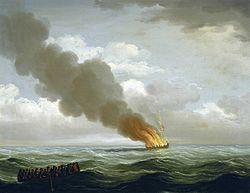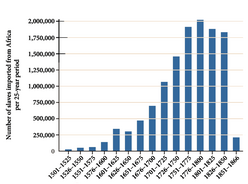Triangular trade


Triangular trade or triangle trade jẹ owo to waye lati igberiko mẹta tabi agbegbe. Triangular trade ma n ṣẹlẹ nigbati igberiko kan ba gbe ọja lọsi ibi ti wọn ti nilo rẹ ti eyi ṣi jẹ agbegbe ti wọn ti ma n gba ọja wọle. Eyi ni a ma fin ṣè ale kun ba awọn owo ti o ku ju ṣuwọn ni oriṣiriṣi agbeegbee[1][2][3].
Oko Ẹru Atlantic Olọna Mẹta
[àtúnṣe | àtúnṣe àmìọ̀rọ̀]

Owo ti ọlọna mẹta to gbajumọ julọ ni owo ẹru ṣiṣe ọlọna mẹta larin ile Europe, Afrika ati America lati Century mẹrin dinlogun ati ọkan dinlogun. Ọkọ óju omi awọn ẹru ma n kuro lati ibudo awon Europe (Gẹgẹbi Bristol and Nantes lọsi Ibudo Afrika pẹlu oja ti wọn ṣe ni ilẹ Europe. Nibẹ, awọn olowo oko ẹru ṣiṣe ma nta awọn ẹru ilẹ Afrika pẹlu gbigba ọja lẹyin naa ni wọn lọsi ilẹ America lati ta awọn ẹru naa ni ilẹ Europe. Awọn ẹru ilẹ́ Afrika ni wọn ma nlo lati fi ṣiṣẹ ni inu oko lati ṣiṣẹ lori oun agbẹ gẹgẹbi Sugar,Cotton ati Tobacco. Awọn oloko ẹru tita nigba miran lati ilẹ Europe maa n wasi ilẹ Afrika fun rawọn[4][5][6][7][8][9].


Iṣiro
[àtúnṣe | àtúnṣe àmìọ̀rọ̀]Gẹgẹbi iwadi ti ile iwe giga ti Emory muwa[10] ati Henry Louis Gates Jr.Owo Oko Ẹru ti Trans-Atlantic ṣiro si 12.5 milionu ẹru ti wọn gbe lati ilẹ Afrika lọsi colonies ni North and South America. Website Voyages: The Trans-Atlantic Slave Trade Database ko data lori awọn ti wọn ti ko sẹyin lati ilẹ Africa past trafficking in slaves from Africa. Eyi firan wa pe awọn orilẹ to ko ni lẹru julọ ni Portugal, Great Britain, France ati Spain.
| Flag of vessels carrying the slaves | ||||||||
|---|---|---|---|---|---|---|---|---|
| Destination | Portuguese | British | French | Spanish | Dutch | American | Danish | Total |
| Colonial Brazil;Portuguese Brazil | 4,821,127 | 3,804 | 9,402 | 1,033 | 27,702 | 1,174 | 130 | 4,864,372 |
| British West Indies;British Caribbean | 7,919 | 2,208,296 | 22,920 | 5,795 | 6,996 | 64,836 | 1,489 | 2,318,251 |
| French Caribbean | 2,562 | 90,984 | 1,003,905 | 725 | 12,736 | 6,242 | 3,062 | 1,120,216 |
| Hispanic America;Spanish Americas | 195,482 | 103,009 | 92,944 | 808,851 | 24,197 | 54,901 | 13,527 | 1,292,911 |
| Dutch colonization of the Americas;Dutch Americas | 500 | 32,446 | 5,189 | 0 | 392,022 | 9,574 | 4,998 | 444,729 |
| United States | 382 | 264,910 | 8,877 | 1,851 | 1,212 | 110,532 | 983 | 388,747 |
| Danish West Indies | 0 | 25,594 | 7,782 | 277 | 5,161 | 2,799 | 67,385 | 108,998 |
| Europe | 2,636 | 3,438 | 664 | 0 | 2,004 | 119 | 0 | 8,861 |
| Africa | 69,206 | 841 | 13,282 | 66,391 | 3,210 | 2,476 | 162 | 155,568 |
| did not arrive | 748,452 | 526,121 | 216,439 | 176,601 | 79,096 | 52,673 | 19,304 | 1,818,686 |
| Total | 5,848,266 | 3,259,443 | 1,381,404 | 1,061,524 | 554,336 | 305,326 | 111,040 | 12,521,339 |
Itọkasi
[àtúnṣe | àtúnṣe àmìọ̀rọ̀]- ↑ "Key Facts". Encyclopedia Britannica. 2020-11-23. Retrieved 2023-08-25.
- ↑ "The triangular trade routeThe triangular tradeNational 5 History RevisionBBC Bitesize". BBC Bitesize. 2023-01-27. Retrieved 2023-08-25.
- ↑ "Transatlantic Slave Trade". Slavery and Remembrance. Retrieved 2023-08-25.
- ↑ "The Triangle of Trade: Definition, Map, and Impact". Students of History Teaching Resources. Retrieved 2023-08-25.
- ↑ "Triangular Trade Route". study.com. Retrieved 2023-08-25.
- ↑ "Triangular Trade: Definition & Importance". StudySmarter UK. 2023-04-04. Retrieved 2023-08-25.
- ↑ "Transatlantic trade (article)". Khan Academy. 1941-12-07. Retrieved 2023-08-25.
- ↑ "The history of the transatlantic slave trade". National Museums Liverpool. 2020-07-10. Retrieved 2023-08-25.
- ↑ "How the Trans-Atlantic Slave Trade Created the African Diaspora". HISTORY. 2022-02-03. Retrieved 2023-08-25.
- ↑ Slave Voyages
